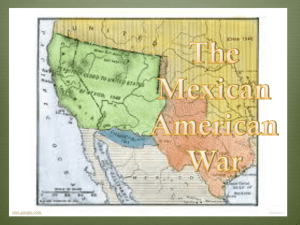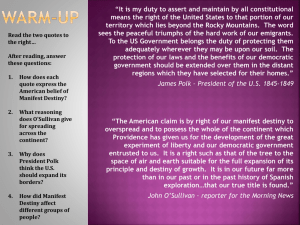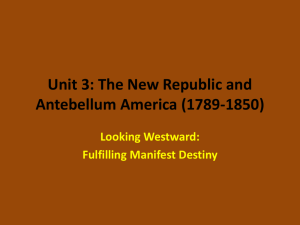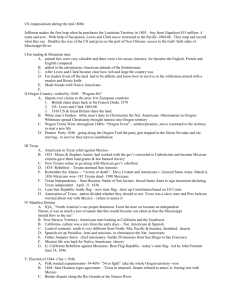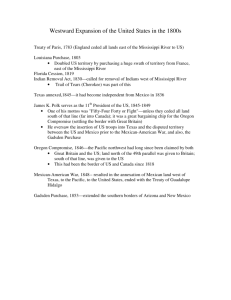Study Guide Nash, 11 Moving West “Manifest Destiny”: The basic
advertisement
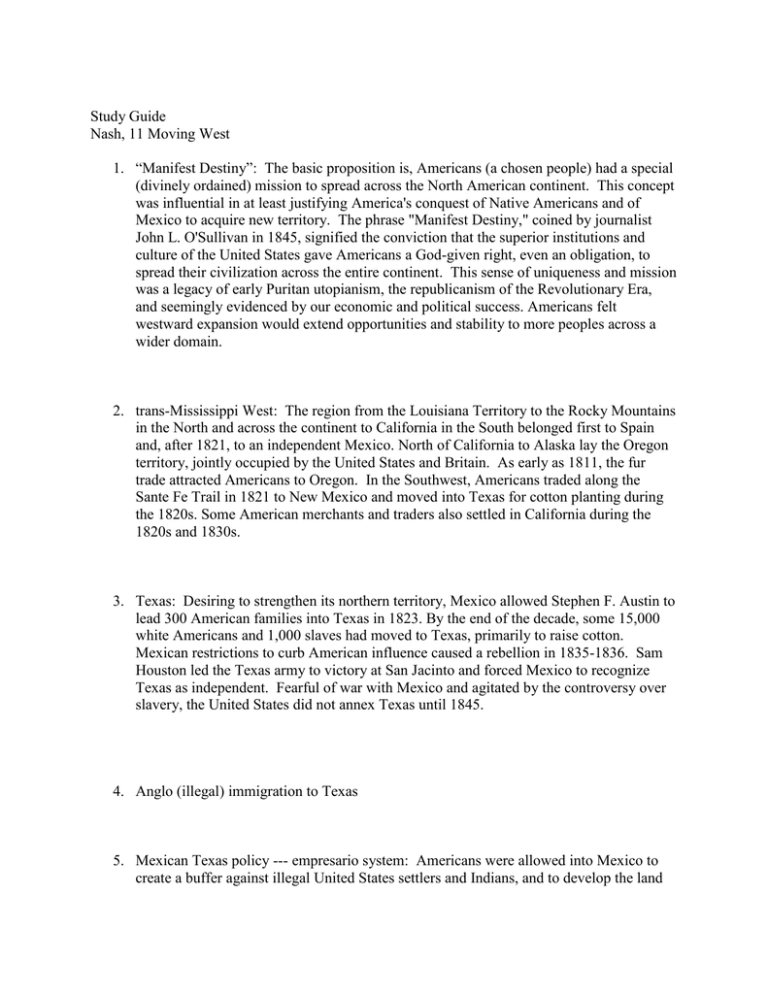
Study Guide Nash, 11 Moving West 1. “Manifest Destiny”: The basic proposition is, Americans (a chosen people) had a special (divinely ordained) mission to spread across the North American continent. This concept was influential in at least justifying America's conquest of Native Americans and of Mexico to acquire new territory. The phrase "Manifest Destiny," coined by journalist John L. O'Sullivan in 1845, signified the conviction that the superior institutions and culture of the United States gave Americans a God-given right, even an obligation, to spread their civilization across the entire continent. This sense of uniqueness and mission was a legacy of early Puritan utopianism, the republicanism of the Revolutionary Era, and seemingly evidenced by our economic and political success. Americans felt westward expansion would extend opportunities and stability to more peoples across a wider domain. 2. trans-Mississippi West: The region from the Louisiana Territory to the Rocky Mountains in the North and across the continent to California in the South belonged first to Spain and, after 1821, to an independent Mexico. North of California to Alaska lay the Oregon territory, jointly occupied by the United States and Britain. As early as 1811, the fur trade attracted Americans to Oregon. In the Southwest, Americans traded along the Sante Fe Trail in 1821 to New Mexico and moved into Texas for cotton planting during the 1820s. Some American merchants and traders also settled in California during the 1820s and 1830s. 3. Texas: Desiring to strengthen its northern territory, Mexico allowed Stephen F. Austin to lead 300 American families into Texas in 1823. By the end of the decade, some 15,000 white Americans and 1,000 slaves had moved to Texas, primarily to raise cotton. Mexican restrictions to curb American influence caused a rebellion in 1835-1836. Sam Houston led the Texas army to victory at San Jacinto and forced Mexico to recognize Texas as independent. Fearful of war with Mexico and agitated by the controversy over slavery, the United States did not annex Texas until 1845. 4. Anglo (illegal) immigration to Texas 5. Mexican Texas policy --- empresario system: Americans were allowed into Mexico to create a buffer against illegal United States settlers and Indians, and to develop the land and resources of Texas to increase tax revenues. Mexico adopted a new policy because of the rush of large numbers of immigrants, illegal entry of some settlers, the "anglicization" of Texas, and the fact that, against Mexico's wishes, Americans brought their slaves. Although invited to settle in Texas during the 1820s, Americans never fully complied with Mexican requirements and finally rebelled. The United States provoked war by invading Mexican territory in 1846, a war to steal the California and New Mexico territories it coveted. The United States had ready conspirators in place in California. The Treaty of Guadalupe Hidalgo wrested one-third of Mexico's territory away. The Spanishspeaking residents were soon overwhelmed and displaced by a huge influx of Anglo settlers. 6. Mexico and slavery, 1829 7. Texas independence --- Lone Star Republic, 1836-45 8. Texas annexation? Pro: Antislavery Britain would grab Texas if the United States didn't, then use it as a haven for runaway slaves from the United States. Also, Texas could be a new slave state (or states) to maintain southern power in the Union. Anti: A proslavery Texas would upset the balance of power in the Senate and open the door to the further expansion of slavery. 9. Polk Presidency, 1844-48 – Polk was elected on an expansionist pledge. Mexico was weak. Polk feared Britain was planning to seize Texas and/or California. Polk saw war with Mexico as a chance to expand the area of slavery. Success in war with Mexico would win the prize of California. 10. Texas annexation, 1845 11. The Oregon question: President Polk "had little desire to go to war with Britain" over the Oregon question but was accused by some of having "deliberately provoked Mexico into war." Polk feared a two-front war with Mexico and Britain; Polk was a proslavery southerner and was not interested in fighting for northern territories that would become free states; Polk thought northern Oregon was not suitable for agriculture. Polk was perhaps both lucky and smart concerning Oregon. Although he had capitalized on expansionist sentiment for political support, he privately favored compromise in Oregon. While Polk's attitude offended the British, large numbers of American migrants to the territory and the diversion of British interests elsewhere helped strengthen America's position. As war loomed with Mexico, Americans also desired a compromise, one Polk achieved at little political cost by "sharing" the treaty with the Senate in advance. 12. California and Asian Pacific trade 13. Pretext for War -- Nueces and Rio Grande Rivers 14. “American blood on American soil” 15. Spot Resolution 16. War with Mexico, 1846-1848 (southern agenda): Polk secretly ordered the navy to seize California in the event of war; Slidell was instructed to buy California; there were rumors that Britain was going to make California a protectorate; Polk instructed the United States consul in California to encourage Californians to agitate for annexation to the United States; Lt. Gillespie was sent to California to foment rebellion against Mexico; General Kearny was dispatched to seize New Mexico and California the moment war began; Polk accepted the terms of the Treaty of Guadalupe Hidalgo which ceded California to the United States. Many would argue that war is only justified in self-defense and that the Mexican War was fought to extend rather than protect American soil. Some may argue the war as necessary to secure our borders and ourselves against the instability of Mexican politics. The supposed benefits of Manifest Destiny and the protections of the Treaty of Guadalupe Hidalgo for the residents of newly acquired territories offered selfserving rationalizations for American expansion. 17. Wilmot Proviso: The Wilmot Proviso was a key to the coming of the Civil War. It generated a divisive debate over the expansion of slavery into the western territories. Southerners insisted slavery must expand or die, antislavery northerners insisted that containing slavery would kill it. The future of the Union seemed at stake--the land of the slave, or the home of the free. 18. San Patricios 19. Treaty of Guadalupe Hidalgo, 1848 20. “we didn’t cross the border, the border crossed us” 21. going West ---preemption acts 22. The frontier and the market: Life for pioneer farmers was difficult and lonely. The determination to reestablish familiar institutions was burdened by the dispersity and mobility of the population as well as the chronic shortage of cash. Mining camps were more lively, but disorderly. Most experienced a typical pattern of boom, bust, decay, and death. The fantasies of quick profits materialized for few as mining operations required large capital and mechanical resources. Emigrants to cities such as San Francisco, Portland, and Denver generally pursued business and professional ventures. 23. The mining frontier and eventual capitalization of production 24. white racism on the mining frontier (and everywhere else) 25. The environment and scars of careless exploitation 26. Plains Indian culture: The Plains Indians led an aggressive, nomadic life in search of the buffalo which provided them food, clothing, fuel, shelter, and trade items. Tribal warfare discouraged political unity, and individual tribes were only loosely organized. Initial relations with white emigrants of the 1840s were peaceful. With the white destruction of grass, timber, and buffalo, however, the tribes became more hostile and demanded compensation. In the Fort Laramie Treaty of 1851, the American government offered gifts and payments in return for Indian agreement to tribal boundaries. Features: 300,000 Indians in over 200 tribes; both nomadic and sedentary; diverse in cultures and social organization; Plains Indians horse culture; Pueblo Indians agriculture; Great Basin and California Indians meager existence; Northwestern Indians elaborate social system based on abundance. Impact: lost land; conflict; reduced numbers. 27. degeneration of Indian-white relations 28. systematic destruction of the Plains people (ethnocide and genocide) 29. Crazy Horse, Sitting Bull, Red Cloud, Chief Joseph (the other Mount Rushmore?)


